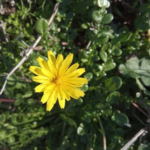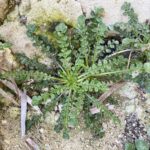Ταραξάκο το αφρογενές
Etymology of Taraxacum aphrogenes: The name of the genus "Taraxacum" derives from the Arabic word "tarakhshaqūn" for a "bitter herb". "Aphrogenes" derives from compount Ancient Greek, from "αφρογενές" [afrogenes], meaning "born on/from the foam (of the sea)", as it is a species that grows by the sea (zero altitudes).
Four Taraxacum species are said to exist in the Cypriot habitat. Taraxacum sect. Ruderalia, additionally, was allegedly recorded in one Cypriot location in 2015 by R. Hand (elevation of 1200 metres).
Taraxacum aphrogenes is also known as the "Paphos dandelion", as it was discovered there and Paphos is the district where it appears. It is a vulnerable, endemic, indigenous species of the Cyprus habitat. Taraxacum aphrogenes grows exclusively on the seashores and its flowering period is from October to March.
How to identify Taraxacum aphrogenes:
In Cyprus, only Taraxacum aphrogenes and Taraxacum cyprium can be found near the sea (aphrogenes only in the Paphos district). Taraxacum cyprium's flowering period though is only between September and November, aphrogenes's extends until March and also includes October.
The best feature that differentiates them is the leaf; Taraxacum aphrogenes has leaves pinnatisect almost to the midrib, with numerous small, oblong-acuminate or suborbicular lateral lobes, separated by smaller lobules. Taraxacum cyprium has leaves runcinate-pinnatifid with broad, deltoid, entire or toothed lateral lobes, occasionally subentire or broadly and irregularly lobed.



